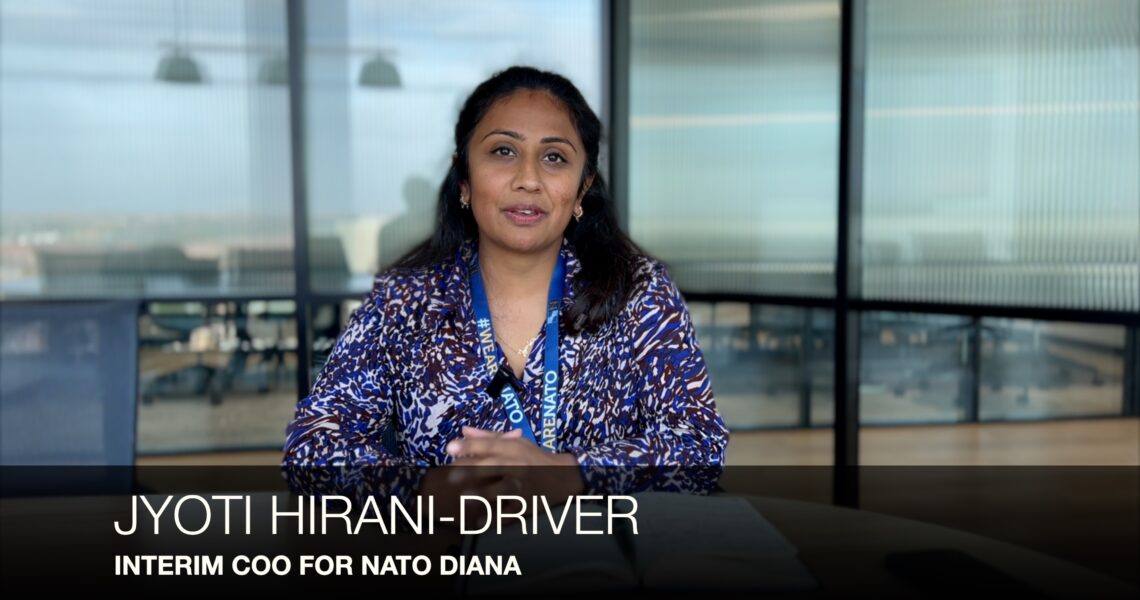Jyoti Hirani-Driver, COO of NATO DIANA. Seeking dual-use innovators.
Given some of the supporting work my business does for the Defence BattleLab on the Dorset Innovation Park, I had been looking to make a connection with NATO DIANA. In fact, the BattleLab is also a test centre for that programme.
DIANA stands for Defence Innovation Accelerator for the North Atlantic, and is an organisation established by NATO to reach out and find dual-use innovations to solve security and defence challenges.
I saw that Jyoti Hirani-Driver was going to be a panel speaker at the Resilience Conference, so I reached out to see if we could do an interview for my ParkLife blog. Unfortunately, we ran out of time as it was a very busy conference, so I jumped on the train to London another time and finally got a chance to asked her about the role of NATO DIANA, how it bring innovators in and the support they are provided with, and what dual-use means, especially in the context of whether businesses are changing their attitudes when it comes to whether working with defence or not.
As of Jan 2025, Jyoti has now become the Chief Operating Officer, from her interim role.
Executive Summary
- The DIANA programme is seeking dual-use innovators
- Innovations that can be used for civil and defence purposes
- The challenge areas cover many areas than just defence
- Funding levels begin at 100,000 euro going up to potentially 300,000 euro in phase 2
What is your definition of innovation?
In the context of defence and security, innovation can be about being transformational or game-changing, but definitely about new capabilities for the armed forces. It can also be about making things more efficient, improving small processes that can help in the civil sector and the defence sector.
What will the P&L be, as in Purpose and Legacy of NATO DIANA?
The purpose of DIANA is to get all of those great ideas, to connect with the innovators who might never have thought about working with NATO to get dual-use innovations into DIANA.
This is not only for the armed forces but also seek those innovations that can work in the civilian sector.
What are your thoughts on the term dual-use?
Dual-use can be a bit of a catch all, which should be seen as a positive.
Any innovation that can help in the civil sector as well as the defence sector is a great thing. It doesn’t need to be defence first.
Are attitudes changing from business as to whether to work with defence or not?
The needs of Defence is not all about lethality or offensive weaponry. There is training needed and process improvements.
The challenges put forward by DIANA include human health and performance, and critical infrastructure. These are more about protection, resilience and security.
Attitudes are changing but there is still a way to go.
How do businesses apply on the challenge areas and what happens afterwards?
The opportunities will be shown on the website and shared to LinkedIn.
It is a fairly lightweight process, where upon a group of experts down selects a number of innovators per challenge area. This happens annually.
Once accepted, they go into the accelerator programme and the first six months (phase 1) they are given the skills, the network and the expertise to advance their technology and business too.
They also get access to the 82 test centres in the DIANA network.
There is 100,000 Euro funding provided and the Intellectual Property remains with the business.
If they successfully complete phase 1, then as part of phase two they could get up to 300,000 Euro in funding to progress.
The challenges and application process can be found at https://www.diana.nato.int/challenges.html
Contacting NATO DIANA
The website is https://www.diana.nato.int
Meet at their events
